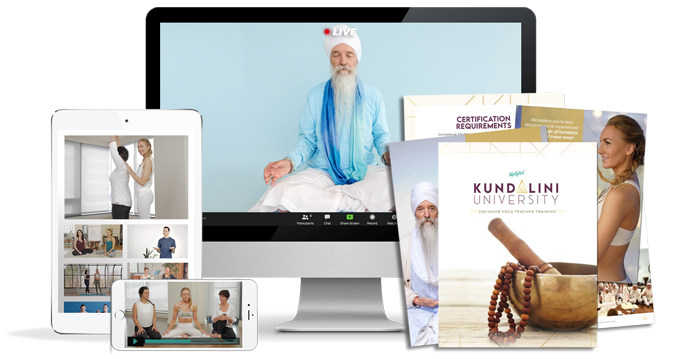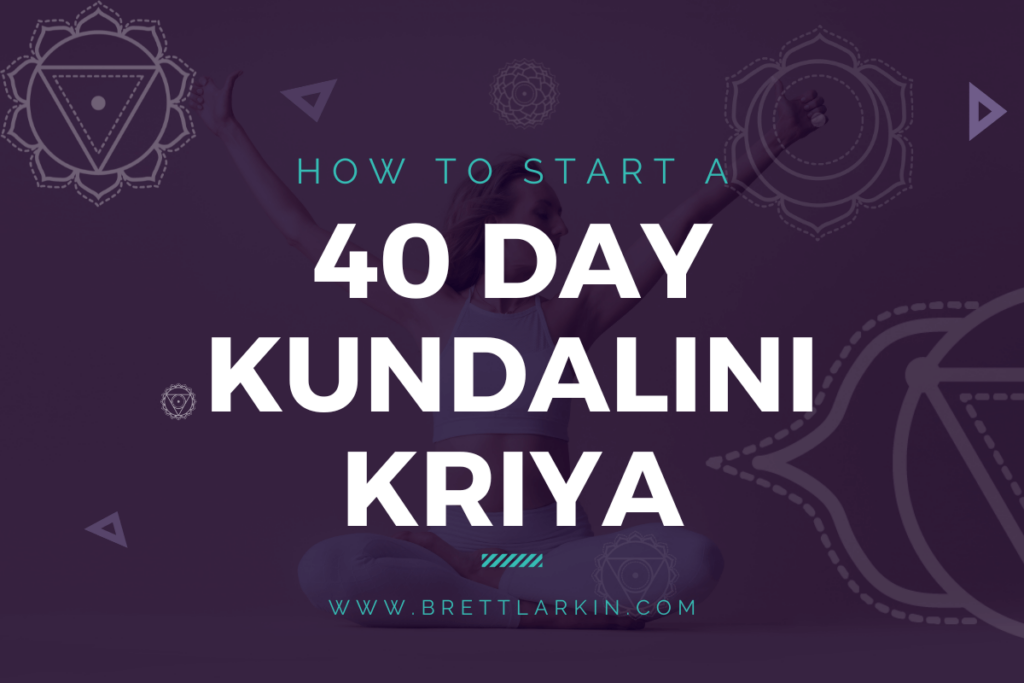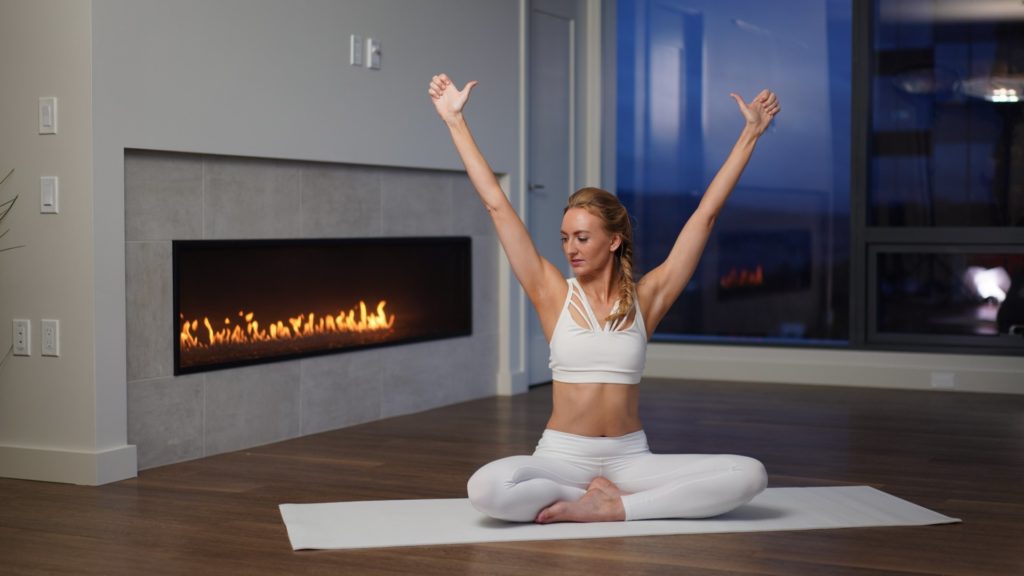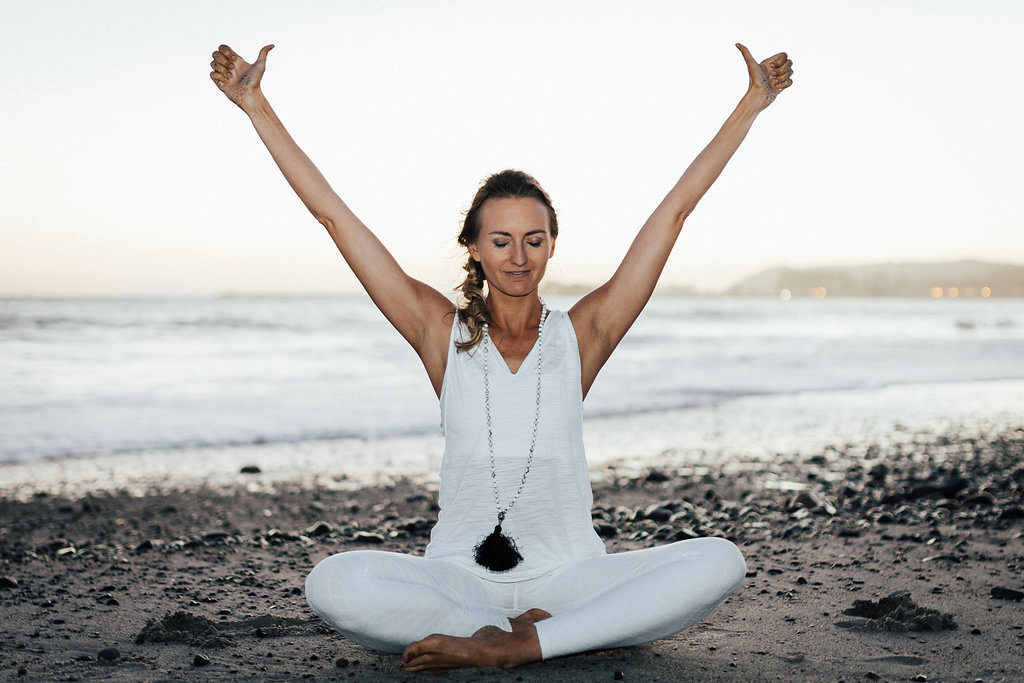Imagine creating consistency in your yoga practice. Transforming your practice into something you desire daily rather than “fitting it in” when you have time. Increasing your body/mind awareness, your capability to live life from a neutral mind, and break negative habits.
Let me introduce you to the 40 Day Kriya.
What Is A 40 Day Kriya?
A 40 Day Kriya is a dedicated practice in which you spend 40 days in a row performing the Kundalini kriya of your choice each day. In this capsule you can experiment, take notice, and ultimately learn a bit more about yourself. On top of all that, it will help to kick-start or re-instill consistency in your ongoing yoga practice.
Let this be an ally for your sadhana, your daily spiritual practice.
Why Do A 40 Day Kriya?
There are a lot of reasons why practitioners do a 40 day Kundalini kriya, which I’ll go over now. But I recommend giving this 10 minute kriya for beginners a try to get an idea of what you’re signing up for for 40 days:
To Increase Personal Integrity and Discipline
Choosing to embark on a 40 Day Kriya practice means you’re doing the same Kundalini kriya for 40 days straight. If you miss a day, you start over at zero and begin again.
Seems harsh? It’s actually a benefit. This gives you guardrails to support consistency and a consequence to motivate you. This practice is a gift you give yourself in the form of an opportunity to strengthen your personal integrity and get in touch with your own sense of discipline not just with your practice but with all areas of your life.
To Experiment with Surrender
40 days straight with one kriya might seem intense, militaristic, or even boring.
Think about it from this perspective: You get to pick one practice and surrender to it each day. In the process, you submit to deeper consciousness.
Place your trust in the kriya that you choose. Maybe it knows best and you’re going let it be a constant for you. Let the kriya do its work on you. See what you bump up against. Let it be a mirror for you to see your habitual patterns and tendencies as they surface.
To Identify Triggers
As you move through your daily practice, try to view everything as an experiment. When you do the same kriya each day it becomes a controlled variable. It gives you an opportunity to study how your mind works. To observe and measure your conscious and subconscious minds and behaviors. It’s an opportunity to learn more about yourself.
Kundalini yoga is designed to trigger you. It might make you feel angry. The end goal of this is to increase your stress tolerance level. When you’re mad about a kriya that pushes you to hold your arms out for a long time, it’s actually an opportunity for you to grow. You begin to feel more calm under pressure and stressful situations on and off your mat. You get comfortable with the uncomfortable.
Know that the physical postures and breath work are engaging your body systematically.
How to Choose a Kriya
Before you can start a 40 Day Kriya practice, you have to choose a kriya. There are so many available, so how do you choose the right one? I have some tips to help you decide with intention!
- Try a few kriyas and see which one you resonate with. Think of this stage like dating. You wouldn’t want to be in a two month relationship with someone before getting to know them a little first, right? Many first dates don’t lead to a second. Not every kriya will resonate with you and that’s normal. You are unique. I have many Kundalini kriya videos available for you in Uplifted and on YouTube. First time working with Kundalini? I highly recommend Kirtan Kriya.
- Be realistic about how much time you have available. If a 60 minute kriya resonates but you know your daily schedule won’t have space for 60 minute sessions, pick one that is 30 or 15 minutes. Remember, your goal is to be consistent. Pick something that you can stick with for a full 40 days.
- Each particular kriya is sequenced for you to focus on different body parts and chakras. If you want to strengthen your abs or low back, look for a kriya that focuses on these areas. If you want something that’s more overall balancing, there are kriyas to address this as well that would be a good place to start exploring.
- Challenge yourself. Don’t skip a kriya just because it has a challenging move. Think of it as something that you can work up to over time. This practice is not about being able to do a kriya well right away. This is a journey. Give yourself the opportunity to make it an interesting one.
- When you trial a kriya, pay attention to how triggering it is for you. You want it to trigger you a little because it’s not going to be an interesting 40 day adventure if the kriya is not poking and provoking you a bit on the first couple days. If it’s too intense and you find that maybe you have trouble with sleep, have constant migraines, or digestive system issues then this probably isn’t the right kriya for you at this time. You want to find one that’s interesting, has a little bit of a trigger to work with, but at a level that isn’t going to overwhelm you.
- You have many opportunities in your life for 40 Day Kriya practices. This is just one of them. Don’t pressure yourself to pick the perfect one. If a kriya resonates with you, it means there was an intuitive connection. This is important! How you will develop and expand your practice is by building trust with your intuition.
Take my chakra quiz to find your dominant chakra:
What To Expect
40 days with the same Kundalini kriya, let alone any yoga class, is not something you normally do. Here is a guide for what you may expect over the course of your journey.
Beginning (Roughly Days 1-14)
You’ll be focused on the physical postures as you become familiar with them. All of your mind chatter will likely be about the poses. “This is hard.” “How much longer do I have to hold this?” “I’m exhausted.” This is normal.
You might feel angry. This may be a hard concept to grasp, but the kriya is not making you angry. It reveals anger that already exists in your system that flares up anytime you react to stress.
Detoxification is also happening at this stage. Your work with the kriya might begin to open clogged energy channels. This is great in the long term, but at this moment it might not feel pleasant.
Detox can take many forms. You may notice you’re really hungry, have a headache, you’re hot or cold, dizzy, or need to use the bathroom more often than normal. Take it slow. If you feel like the detox symptoms are too intense, back off. If they impede on how you live your life, that’s a sign you need to pause your work with the kriya. Choose a different kriya and begin again. If the discomfort is mild, see if you can view this as part of a bigger process and proceed with care.
Make sure you drink enough water. Bodywork can also be helpful to regulate what gets shaken up.
Two Ways to Approach Pose Mastery:
Try to make yourself do all of the poses for the full duration the first time through.
- If you succeed, hold yourself to that baseline. Give yourself a pep talk, “If I can do this once, I can do it every time.”
- If you struggle to make the full pose times, use this as an opportunity to build. Almost all kriyas come with variations to the length at which you can hold the poses. Reduce your hold time to the shorter variations to start, and work your way up. Be happy that you have multiple days to master the poses. For the first 10 days, work with the lower time, it might be 30 seconds instead of a minute. Around day 10 you may feel stronger and choose to advance to a minute. Feel good about the fact that you chose to build up slowly.
Midpoint (Roughly Days 15-24)
Total honesty. At this stage you will probably start to get bored.
You’ve gotten to the stage where you’ve done the class enough times that the postures aren’t a challenge and are no longer novel or entertaining. It’s interesting to observe this boredom.
Your mind might start to wander. This is an opportunity to notice how quickly your attention can drift.
You also have an opportunity to deepen your awareness of your thought patterns. You may notice annoyances or self-dialogues such as that you feel lonely, or sad, or think what’s the point of all this.
You observe your thoughts more effectively in the 40 Day framework. The kriya doesn’t change, instead it acts as a mirror showing how YOU change. When you no longer have to overcome the physical challenge, and anger dissipates, you are able to step into a space of witnessing. It’s an amazing shortcut to greater consciousness.
You may also start to notice how the kriya evens out your energy. Instead of moving through highs and lows, you’re able to move through your day in a more neutral energy. You may notice that you stop being reactionary. Things start to become effortless, a little more natural.
Completion (Roughly Days 25-40)
You might notice that you feel love or reverence for the kriya that you’ve been practicing every single day. It might be harder at this stage not to do the kriya than it is to do it. You are near the end of your 40 days and it’s bitter sweet. It’s like you’re in a relationship with this kriya. You’ve committed and a healing bond has been forged.
Caveat:
While this is a lovely way to end your 40 days, not everyone has the same experience. The path I’ve laid out is common but your experience may not be as linear a journey. Sometimes you feel love or reverence and surrender at the beginning. And then anger in the middle. With boredom at the end.
Whether or not your experience manifests as a linear journey, going over these stages is helpful because it provides you with a map. You can think of this similar to the stages of grief. They don’t always follow a singular order, but the stages exist in processing the emotional energy. What we’ve gone over here together is going to help you unpack your experience.
The Importance of Journaling
Your journal can be an invaluable tool to help you keep track of how the kriya engages with you. Take note of anything that feels different in your body or mind. Maybe you feel a sensation that you hadn’t felt before. Reflect on that. It can also be helpful to take the time to reflect on how you feel emotionally before, during and after you practice the kriya each day.
Want to Explore Kundalini Yoga Even More?
Join me in Uplifted for a 40 Day Kriya Challenge where I provide even more guidance. I’ve also selected some of my favorite kriyas for you to choose from. They have varied focus areas and time lengths to make it even easier for you to begin your exploration.
I also invite you to join me, along with Guru Singh, in our Kundalini University teacher training. Even if you don’t intend to teach, this wisdom-filled training is highly impactful and you’ll expand your Kundalini practice in a very deep way.
40 Day Kriya FAQs
What is tuning in and how do I do it?
Every Kundalini class opens in the same way, by tuning in with the Adi Mantra.
Tuning in signifies the start of your practice and helps you separate your yoga time from the rest of your day. It also links you to the Golden Chain, which is traditionally thought to connect you to all the teachers and sages who came before you.
I feel that the real beauty of the Golden Chain is that YOU get to decide who’s a part of yours. Sit for a moment and think about who/what you would want to include and visualize as your Golden Chain. I know people who visualize a deceased relative, an inspiring figure in their life or even bright white light – infinity. When you take the time to think through this, every time you tune in, you get the opportunity to connect to this beautiful, personalized visualization of your Golden Chain.
Mangala Charan is a protective mantra that is a great option to chant after the Adi Mantra as well.
How do I end my practice?
You always close by chanting the mantra Sat Nam three times. When chanting Sat Nam, each Sat should be eight times longer than the Nam. If you’re in a rush, you can chant Sat Nam once. To perform the chant, your hands will be in the same mudra used to tune in: hands pressed together in prayer at your breastbone, heart lifted, thumbs pressed gently at your sternal notch.
This is a lovely way to seal off your time with your practice and return to your day. Sat Nam is often translated as, “Truth is my identity.” A different translation that I love is, “I am an energy body. I am an energetic being.”
How do I keep my mind from wandering during a kriya?
There are three techniques that can help you stay focused:
- Mantra: Unless specified, you can use the default mantra of Sat Nam to anchor your attention. Sat on each inhale, Nam as you exhale. You can use Sat Nam in every single pose.
- Drishti (Focus Gaze): Unless specified, the default gaze for every pose is the third eye, the space slightly above the area between your eyebrows. Draw your gaze to your third eye to help focus in.
- Bandha (Lock): Unless uninstructed, always engage a light Mula Bandha (Root Lock) in your poses. In addition to giving you something to focus on, Mula Bandha also helps to protect you when you do postures that include twists.
Do I need to wear white?
No. There are many reasons why yoga practitioners wear white.

It can even be a fun way to experiment with your practice based on color psychology. White is the combination of all colors in light. A reason that so much white is worn in Kundalini is because you don’t want to influence yourself unless you know what colors you want to feel in a given moment. If you want to be more active, wear red. Relaxed, more blue tones. Since white is a combination, it’s a more neutral energy.
Like all things, too much of a good thing is still too much. Too much white can be a bit too neutral. You can adjust this by wearing white with pops of color. Experiment. Wear white and see how you feel. Wear dark colors next session, notice a difference?
Do I need a head covering?
No, but again, I invite you to experiment.
Try this: wrap your head with a towel like you just gout out of the shower. How does that feel? Do you notice feeling more awake from the slight tug of your skin? A little upliftment? This is the purpose of wearing a head wrap or turban during Kundalini yoga. The pressure on your head from the wrap puts slight pressure on meridian points, similar to the effect of acupressure, which can make you more alert and aware.
Another option is to put a shawl over your head when you meditate. A cover over your head can give you a sense of a protective shield. That’s why monks wore hoods. To feel enclosed. To go within yourself in a cozy and protected environment.
Your body builds habits and routinely using a head covering can be helpful as you work to establish your sadhana.
Can I adapt or modify my kriya if I’m sick or on my menstrual cycle?
Absolutely! This is your practice. If you are sick or on your menstrual cycle and any pose feels uncomfortable, modify as you need to. Remember that visualization also has immense benefits when you are physically unable to do a pose.
- If you become sick and don’t want to miss a day for fear of starting over at day 1, here is what I think: YOU get to set your own rules and make this what you want it to be. What I would suggest you do is come to your mat during the time that you’re usually doing your kriya and do what you feel like doing. If you just want to lie in shavasana and listen to the instructions, do that. This is ultimately about cultivating the ritual of coming to your mat. Even if you’re missing 80% of the practice because you’re just lying down, you’re still absorbing the energy of the ritual.
- If you’re on your menstrual cycle, it’s advised that you not do Breath of Fire because it brings energy up your spine. When shedding uterine lining there is naturally a downward current of energy. The amount of time you avoid these practices will vary for each individual. For me personally, I skip Breath of Fire for the first one or two days of my cycle. I add a light Breath of Fire when I feel ready.
- Omitting Breath of Fire also applies to people who are pregnant. Also, if pregnant, don’t lie down on your belly. I have an entire course called Pregnant and Powerful which is a combination of Kundalini and Vinyasa yoga for pregnant women. It helps you bring yoga into every aspect of your pregnancy, birth, and postpartum.
Why 40 days?
Yogi Bhajan said that it takes about 40 days of consistent practice to break a habit and it actually takes 90 days to establish a new habit in the subconscious. This timeframe of 40 days will break a lot of your habitual thinking and help you establish some new routines and habits.
What if I want to keep going after 40 days?
40 days is the starting point and you do have the opportunity to extend your time. Some people continue for 90 or 120 days. At 120 days the impacts of the kriya are considered to be integrated permanently. We’ve had Uplifted members who’ve done that and say it’s incredible. Be aware of repetitive stress. Doing the same practice every day isn’t optimal. The body wants movement diversity.
What do I do if I miss a day?
Start over. Don’t worry! It’s very normal to start over. Most people embark on their first 40 day practice, make it to day 10, and slip up. They go back to day 1. You need to embrace that and get excited about it. It’s part of the process.
Do I need to practice at the same time each day?
There’s no rule that says you need to practice at the same time each day but I find that my students are most successful when they do.
Real estate’s 3 rules are, “Location, location, location.” For your 40 Day Kriya I want your rules to be, “consistency, consistency, consistency.” It’s going to be so much easier to be consistent when you do your practice at the same time each day.
Please move forward with the knowledge that it may take more willpower on your part to finish the 40 days without a consistent plan in place before you start.
What is “Amrit Vela” and why is it considered the best time to practice?
The pre-dawn hours, beginning about 90 minutes before sunrise, are referred to as the Ambrosial hours, Amrit Vela, and/or brahmamuhurtha as it is referenced in the Yoga Sutras.
During this period of time, it’s believed that the angle of the sun’s rays approaching earth have a heightened effect on your energy body which makes your practice more potent. Additionally, taking this time to center before the start of your day can allow you to prepare yourself for anything that comes your way. Practicing at this time gives you an opportunity to change the dynamic of how everything else in your day unfolds.
One of the definitions of sadhana that I love is that it’s the “opportunity for the individual mind to meet the universal self.” To perform your sadhana at such a special time of the day can be a uniquely impactful experience.
Do I need to practice pre-dawn?
You have the autonomy to choose which time of day will work best for you to practice consistently. That being said, I strongly recommend the morning as the best time.
It’s ok if your schedule doesn’t allow you to practice in the morning. If evenings are more consistent for you, that’s when you commit to showing up.
But I’m so tired in the morning. How do I find the motivation to get out of bed to practice?
Set yourself up for success the night before. Try to eat and go to bed earlier. Before you get into bed, set out all the things you’ll need like your mat, a cushion, Kleenex, a water bottle, and any other props you usually use. For cooler mornings, maybe include some socks and a meditation shawl. All of this prep will help ensure your practice happens. It can be helpful as you get into bed to visualize your morning sadhana. Think about how much you’re looking forward to getting up early for it.
Can I do two 40 day kriyas at once?
Yes! This is your opportunity to self-study and experiment. If you start to feel like you are doing too much and you notice that you aren’t able to complete each of the pieces you’ve committed to, you can scale back.
It can be helpful to select some non-negotiable parts of your practice. In this case, the first kriya that you selected. Think of this kriya as your big rock. Each of the additional practices you add on are little rocks, that you lay out around your big rock. These little rocks can be moved and adjusted but you’ll always have your central core component anchoring your practice.
Can I practice other styles of yoga before or after my kriya?
Yes. Listen to your intuition. Let it guide you to compile a sadhana that is the right fit for you. Maybe you like to do a vinyasa flow before practicing Kundalini to feel more limber after a day in the office. Or maybe you like to do some more gentle stretch poses after your kriya to further ground yourself. Don’t overthink it. Your choice may look different each day.
Can I do a different type of yoga for my 40 day practice?
Yes. It’s going to provide you with consistency and there is value in doing a 40 day practice with a non-Kundalini meditation. We even have a 40 Day Yoga Nidra program in Uplifted. However, I’m not the biggest fan of doing a 40 Day Vinyasa practice due to the chance of repetitive stress injury. I’d rather you vary up your movement.
All that being said, a 40 day practice with a different type of yoga is not going to provide you with clarity like a Kundalini kriya would. What’s special about Kundalini is it incorporates multiple pieces of the 8 Limbs of Yoga such as asana, meditation, mantra and pranayama. This develops the physical, energy, and mental bodies as a whole system. Every sadhana is considered a complete set. This is why Kundalini is so powerful and provoking.
Kundalini was developed for the layperson. A lot of the exercises are challenging but you’ll notice that there are never poses like headstand where people could risk injury.
If you are going to pick a non-Kundalini class, I advise you to pick a meditation. If you want to pick a Vinyasa class, choose something that’s easy on your body.
Can I add a meditation to my kriya?
Yes! Just like picking a kriya, there’s no such thing as a wrong choice. Trust that the meditation you are drawn to is for a reason.
If you need guidance, focus on the chakras. Where is the kriya that you’re practicing centralizing or moving energy? You could pick a meditation that expands upon that area. You can also do the opposite. Maybe a kriya that has your arms up over your head a lot leads you to decide to incorporate a meditation that will be more grounding to add some balance.
You can also focus on specific parts of the body. If the kriya you are practicing works your glands, a specific organ, or your nervous system there are meditations you can include to compliment those.
I have many meditations for you to choose from in Uplifted and on YouTube.
Help! I can’t keep up! The practice goes too fast, should I bother continuing?
Always go at your own pace. You want to find your own personal rhythm. It doesn’t matter what your teacher’s rhythm is or the rhythm of students next to you if you’re in in-person Kundalini yoga class. This is about you coming into your own rhythm and learning about yourself.
I struggle to sit up straight. Is posture important?
As well as you can, aim to have a long spine and your chest lifted. If the chest and heart aren’t lifted, the Kundalini energy can get blocked. Remember to lift the heart, lift the chest and present your heart chakra out to the world.
What is Breath of Fire?
Many kriyas incorporate Breath of Fire. Please check out my Breath of Fire tutorial to maximize its positive benefits. If you get tired, take a break and come back to it. Or find a slower, more rhythmic pump. The breath is really all about your belly. You want abdominal engagement. This is also a chance for your digestive system to get a workout to pump food through the digestive tract.
I struggle with motivation. How do I stay consistent?
Tell your family and friends that you are embarking on this 40 day adventure. Let them know that this is something you’re trying to do and ask for their support. Let them be there for you in your weak moments, when you don’t feel like practicing. They can be your cheerleaders. This would also be a wonderful thing to do with a friend for extra accountability.
Be smart about when you start and your timing. This is a very challenging thing to do. Set yourself up for success and start it during a period where you’re going to be at home for those 40 days. No big plans, no big travel.
What if I can’t do some of the poses?
Get excited! Ideally, you want to not be able to do some of the poses because you want to be able to acclimate to the kriya over time. If the kriya were easy from the start, it wouldn’t be that interesting to do for 40 days. Know that you have 40 days to work with this. Notice how you gradually progress and increase your stamina over time.
As you begin, make sure to take breaks when you need to. Bless yourself. Honor yourself. Stay positive. Take that break, and then come back in as you feel ready. If you do take a break, try to come back in for the end of the pose when you engage and hold the bandhas.
That being said, if you can’t do something due to an injury or surgery, the best thing to do is visualize doing the pose. Close your eyes. Get meditative and imagine yourself doing the pose. This has an impact.
What is the best way to ground after a Kundalini practice?
Savasana. Make sure you leave ample time at the end of your kriya for a lengthy savasana. Five to eight minutes is ideal.
During your 40 Day Practice, go outside as often as you can. Take your shoes and socks off. Find some bare ground and just stand there. Can’t get outside? Try to spend time with as much of your body in contact with the floor as possible. Child’s pose, cobra pose, and supine twist are all great examples of poses you can do to ground your energy.
Is Kundalini yoga only good for igniting energy? What if I want to focus on grounding energy, relaxation and the lower chakras? Is Kundalini yoga still good for me?
This is something that confused me for years. A lot of people told me that Kundalini yoga classes weren’t good for someone with my constitution because I have high Vata and it brings too much energy up.
The reality is that consistency is great for the lower chakras! It gets you in a rhythm and the lower three chakras love consistency and routine. Also, Kundalini yoga isn’t just about raising energy, it’s about circulating energy.
If your goal is to ground, try one of the relaxation kriyas that I have for you on YouTube.
Next Steps
- Watch my Kundalini playlist on YouTube for more Kundalini kriyas, mantras, and meditation.
- Join my Chakra Challenge! And get to know each chakra through your yoga practice. Open up a whole new dimension in your yoga practice.
- Try my Kundalini Demystified 30 HR teacher training course. It’s the perfect intro to Kundalini yoga, the serpent, and more!
Get 3 Free Training Vidoes from our Kundalini University Experience & Certification Program

YOU MIGHT ALSO LIKE
- Ong Namo Guru Dev Namo: The Adi Mantra Explained [VIDEO]
- Kirtan Kriya: Kundalini Meditation That Will Make You Feel Better
- Sat Nam in Kundalini Yoga: Sanskrit Translation and Meaning
- Sat Kriya: A Yoga Practice You Can Do in 3 Minutes
- Shuni Mudra: The Seal of Patience
- Buddhi Mudra: What Is It And How Do You Use It?
- Adi Shakti Mantra: Manifest Your Divine Femininity
- Venus Mudra: The Seal of Clarity & Empowerment
- Why the Aquarian Sadhana Is The Ultimate Morning Yoga Practice
- The 7 Aquarian Mantras: Tune In To Profound Transformation
- What is Japji? The Sacred Ritual, Explained
- Chanting Mantras: Unlock the Secrets of These Spiritual Formulas
- 8 Kundalini mudras for health and energy
- How to Chant the Mangala Charan Mantra (With Pronunciation)
- The Kundalini Kriya For Elevation, Step-By-Step
- What is Kriya Yoga? The Philosophy and Practice
- Surya Mudra: What Is It And How Do You Use It?
- Meaning of Ra Ma Da Sa: The Healing Siri Gaitri Mantra
- Subagh Kriya: What Is It And How Do You Do It?
- Vasti Kriya: 3 Yogic Intestinal Cleanses
- Nauli Kriya: How To Practice This Cleansing Shatkarma
- The Ancient Art of Dhauti Kriya in Yoga: Cleansing and Purification
- Kundalini Yoga: How To Start A 40 Day Kriya
- Understanding The 6 Shat Kriyas In Yoga
- What Is Sat Nam Rasayan? How And When To Practice
- The Sa Re Sa Sa Mantra: Connecting Breath, Light, and Creativity
- The Power of Humee Hum Brahm Hum Mantra for Connection and Healing
- Tantric Har Chant: How It Fuels Prosperity and Inner Power















